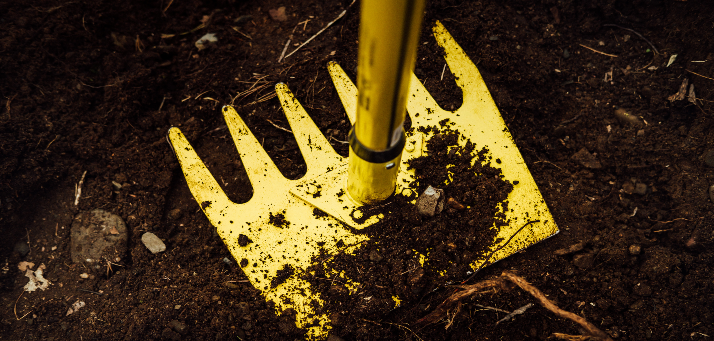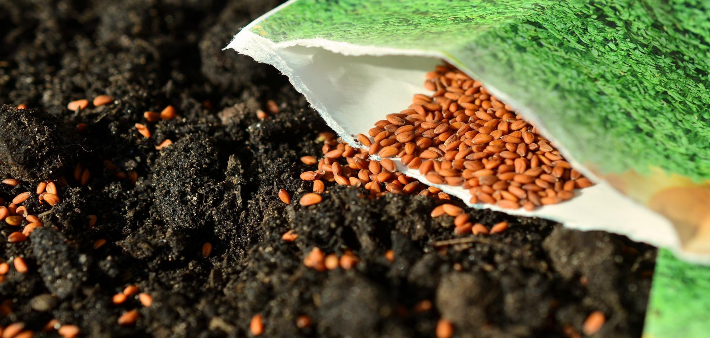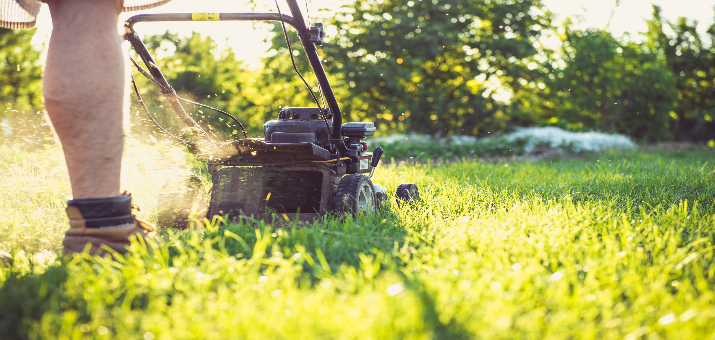
Growing your lawn from grass seed in 3 easy steps
A lush green, beautiful and healthy lawn is almost everyone’s desire. After all, who would not like a cozy, natural place for some fresh air to themselves? But growing luscious, soft grass in your backyard can look like an intimidating process.
Maybe the day the grass starts to seem greener on the other side of the fence on your neighbor’s lawn is the time you take it as a sign to finally start working with your existing lawn. To tackle this tiresome thought of where to start and what to do, we have your back.
In this blog, we bring you a breakdown of steps with all the information you might need to begin growing your green lawn. We will first look into all the requirements - what type of grass seed to choose, how and when to prepare the soil, and then dive into the steps for actually setting up your lawn. If you are interested in some extra tips and tricks, keep reading.

Step 1: Preparation for planting in the new lawn
Any backyard can look and feel different with a freshly cut lawn, but it is easier to witness the results when choosing the grass seed with the fastest growth and to know how to grow lawn grass seeds properly. Timing also is crucial when planting grass seed.
To maximize your home’s green space with lawn grasses, here are a few easy and quick steps for prep work:
Picking the right season of the year
It can be really exciting to envision having the ideal lawn and all the greenery it might bring along. However, if you plant too soon or in a rush, it could be more difficult for your grass to establish itself. Similarly, planting your seeds in harsh extreme weather is not likely to yield any good results.
Planting during the sweltering heat of the summer means more water will be required to hydrate the seed and, thus, the chances of ruining the plant. However, other people advise planting warm-season grasses now so that the lawn has a chance to get used to the heat. While it may seem simpler and less exhausting to plant in the winters, it isn't the best time to cultivate grass either, as the winter might trigger dormancy in grass seeds.
Depending on your region and the type of grass you want to grow, either spring or fall is the optimal time to plant grass. If you live in the cooler areas of the country, the best time to plant grass would be in the fall. But you should probably plant in the spring or early summer if you live in the southern or middle regions where it is comparatively warmer.
However, it would be nice to consider that the grass seed germination will be slightly slower in spring as compared to autumn when the soil is warm and moist.
Choosing the right type of grass seed
Not all grass is made to thrive in all environments and temperatures. To make sure you choose the most appropriate grass, it will be helpful to determine the weather and shade conditions of the region you'll be working in. Based on this information, you can choose from warm season grasses, transition zone grasses, or cool season grasses.
-
Warm season grasses:
Bermudagrass, Bahiagrass, Zoysia, and Centipede grass, St. Augustinegrass, and Buffalograss
-
Transition zone grasses:
Zoysia grasses, Fescue / Bluegrass blends, and Bluegrass / Perennial Ryegrass blends
-
Cool season grasses:
Kentucky bluegrass, Perennial ryegrass, Tall fescue, Fine fescue, Bentgrass, and Creeping fescue.
Each grass has distinct advantages and disadvantages. For instance, Kentucky Blue can take shade but needs a fair quantity of water to thrive, whereas Couch is hardy but dislikes shade. You must keep the environment of the lawn in mind to choose the right grass seeds.
Not just the region, but we also have options to explore grass seed blends based on the purpose of the lawn. There is the ideal grass seed mix for you, whether you want a multipurpose lawn, a lawn for a bowling alley, or a durable football field. Additionally, there are lawn seed mixtures available for dry and shaded settings.
Strong red fescue and perennial ryegrass are typically used to create durable lawns. Low-growing, fine-leaved, slender red fescue and bentgrass are frequently found together in ornamental lawns.
Prepare the soil
Before anything else, you need to make sure you have a nice, sturdy foundation, whether you are planting for the first time or simply overseeding your already thinned-out grass. This will ensure that your soil is smooth and full of nutrients and oxygen to support germination. Follow these steps for soil preparation:
-
Loosen the soil
You must at least loosen the top four to six inches of lawn soil. You can rake or use a tiller to do so. This will permit airflow, break large clumps of compacted soil, and provide the plant its greatest chance for robust growth.
At this point, you can also spread a thin layer of topsoil on the lawn. It won't be compacted because it was just laid, allowing for adequate airflow. Make sure to save enough for finishing covering.
If you are working on an existing lawn that is in poor condition, you can use a sod cutter or a nonselective broad-spectrum herbicide to prepare your soil for loosening and the following steps.
-
Remove debris
Your next step is to remove any weeds, rocks, sticks, old or dead grass, debris, or clumps to achieve an even and flat surface on top.
-
Level the soil
Check for any uneven areas on the ground, as these might cause a puddle to form and prevent water from collecting in low areas. This will, in turn, cause the seeds in those areas to rot.
Removing the debris and adding topsoil will also aid you in leveling your lawn for an even look, but it is a good idea to check for yourself to ensure you are completely ready to plant grass seeds. This is a good time to fix any holes in the surface to prevent problems later.

-
Add nutrients and check for pH
If your lawn is dying or having trouble growing, there may be deeper soil problems that need to be resolved before you plant new grass seed.
In this case, or otherwise, you will need to use a pH tester. For the majority of grass varieties, the ideal pH range is 6.0 to 7.0.
Your soil is too acidic if its pH is lower than 6.0, which means it needs nutrients like calcium, phosphorus, potassium, and nitrogen. To assist raise the pH of the soil and boost the availability of those nutrients, lime (also known as limestone) can be applied to the soil.
On the contrary, if the pH is higher than 7, it needs more acid. Add compost, peat, sulfur, or fertilizer to your soil to lower the pH.
Step 2: Sowing grass seed
-
Lay the grass seeds
A brand new grass requires a very substantial application when sowing grass seed. To ensure that everything is coated, try to lay the seeds evenly across the entire surface. Ideally, one and a half ounces of grass seed should be sown per square meter. The first amount should be weighed out, placed in a plastic cup, and marked on one side to serve as a measure. Divide your site into 1 m squares using canes. Distribute one cup of seed evenly throughout each square for convenience. As an alternative, when overseeding an established lawn, you need lighter coverage. To encourage growth, spread out extra grass seeds in bare spots. Simply use your bare hands to disperse the seed or a spreader for bigger areas.
-
Cover grass seed
If the seed is just sown on the top layer of soil, it will dry out soon and not take root. The wind or the water might also carry it away.
To sow grass seed properly, add a second, thin layer of the extra soil you have.
If you don't have soil to cover the seeds, you must work the seed around ⅓ to ½ inch deep into the soil. After planting the seed, smooth the soil's surface and push the seed into the ground using a rake.
This will keep the water from evaporating immediately. Additionally, it safeguards the seeds from animals.
-
Feed the soil
Once again, it is time to feed the soil with nutrients and fertilizers to accelerate growth.
Step 3: Maintaining the lawn
After sowing the seeds, it is a test of patience to nurture them and watch them grow. Here is what you should do while your little seeds grow into the beautiful green of your new lawn:
Water optimally every single day
Watch your newly planted grass seed closely. What you do right away is crucial since they only have one chance to germinate. If you have a mixture of grass seeds, remember that different grass plants germinate at various times. As a result, you'll need to keep watering them until the species with the slowest germination appears.
Make sure to keep the top soil moist, not soggy. Too much water is just as bad as too little. Water at least once in the morning, but try to commit to two to three times a day.
Check Moisture
All your effort will be wasted if you do not keep a moisture check on your small sprouts of grass seedlings. They need to be watered as frequently as the seeds and have to be kept from drying out.
Give the grass its first mow
Finally, when you can see the fruition of your labor, it is time to give your lawn its first mow.
Here are a few tips to keep in mind:
- Sharpen the blades of your mower so it does not tear the grass
- Minimize the number of turns the mower makes
- Start the mower off the grass to prevent any unnecessary cuts
- Do not cut grass blades more than ⅓ rd of the grass height
You can now cut down on shallow watering and shift to watering a couple of times a week. Add some fertilizer to aid growth and help the lawn rood deeply. Continue for almost eight weeks, and voila! Your new and thriving lawn is ready.

FAQs
Will grass seed grow if I just throw it down?
Some might but not all. Without the ideal conditions and on bare soil, the germination rate of grass seeds will diminish. They will not be able to hold a strong root in the ground and eventually die.
How long does it take to grow grass with grass seed?
Generally, you will be able to see new grass seedlings pop out in 7-14 days. However, in other varieties of grass, it might take up to 30 days.
Do you have to bury grass seed for it to grow?
Once you spread the seeds, only use a rake to sow them lightly into the soil, not more than half an inch deep. Grass seeds need optimal light to germinate, and adding a thick layer of topsoil or burying them will only inhibit their growth.
What month is best to put grass seed down?
The best seasons to plant cool season grasses are spring or fall since these northern species of grass need warm soil and cool air. If you’re in the North, you’d want to sow grass seeds in the fall, which means around September up till November.
Warm season grasses can be sown in the South any time between late spring and mid-summer, which means from March to June. Wait until there is no longer a chance of a late frost and the daytime high is in the 80s.
Products
View all

